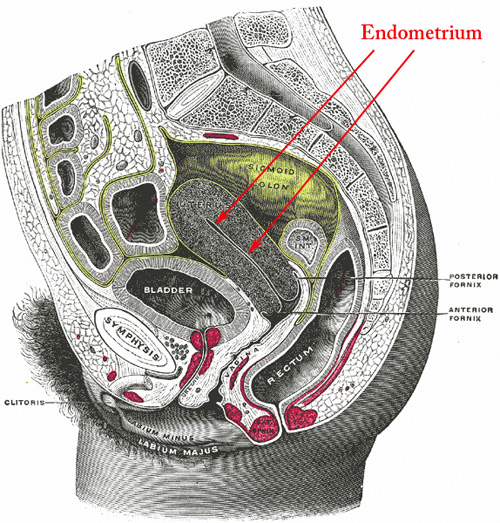Endometrium

Endometrium
The endometrium lines the uterine corpus and exhibits two chief constituents - the endometrial glands and endometrial stroma. The inactive, prepubertal endometrium shows a cuboidal to low columnar epithelium that lines the surface and the underlying glands. The appearance greatly resembles the inactive endometrium seen in postmenopausal women, as both prepubertal and postmenopausal endometria do not exhibit any proliferative or secretory changes that are hormone dependent. The endometrium in the reproductive female may be considered to comprise of a deeper basal layer and a superficial functional layer. The functional layer is subdivided into two strata - the compactum (towards the surface) and the spongiosum (towards the basalis).
With the onset of menarche, the menstrual cycle follows three well-defined phases, each exhibiting a distinct morphology. The phases seen in a classic 28-day cycle are distributed as follows:
Day 1-5 Menstrual Phase
Day 5-14 Proliferative Phase
Day 14-15 Ovulation
Day 15-28 Secretory Phase
The first day of bleeding is considered Day 1 of the cycle and heralds the onset of the menstrual phase. The superficial functional layer undergoes necrosis and is accompanied by a neutrophilic infiltrate. During the proliferative phase the endometrial glands, stroma and vascular endothelium all proliferate leading to an increased volume of the endometrium. The glands are lined by a stratified columnar epithelium with interspersed ciliated cells. The epithelium contains mitotic cells and increase in tortuosity in the mid and late proliferative phase. The stromal edema is most marked at the mid-proliferative phase. During the proliferative phase, daily morphologic alterations are not sufficiently obvious to permit accurate dating. At the secretory phase the daily changes during the postovulatory period are sufficiently distinct to permit accurate evaluation of the endometrial cycle. Parameters including subnuclear vacuolation, nuclear palisading, stromal edema, ferning of glandular epithelium, perivascular and stromal decidualization and neutrophilic infiltrate can all be used to define the exact day of the cycle. However, endometrial dating, even in experienced hands is not highly reproducible. When accurately performed, endometrial dating provides valuable information.
Cancer: Endometrial cancer
|